Multi-Source Monitoring Data Fusion Comprehensive Evaluation Method for the Safety Status of Deep Foundation Pit
Abstract
1. Introduction
2. Safety Status Assessment System of Deep Foundation Pit
- Stage 1: Identifying evaluation indicators from the DFP monitoring content and establishing safety level standards.
- Stage 2: Considering the interrelationship of evaluation indicators to determine the subjective weights by GDEMATEL.
- Stage 3: Utilizing the information discrepancy of field measurement data to determine the objective weights by entropy method.
- Stage 4: Merging subjective weights with objective weights by game theory.
- Stage 5: Safety status comprehensive evaluation by the Game-CM method.
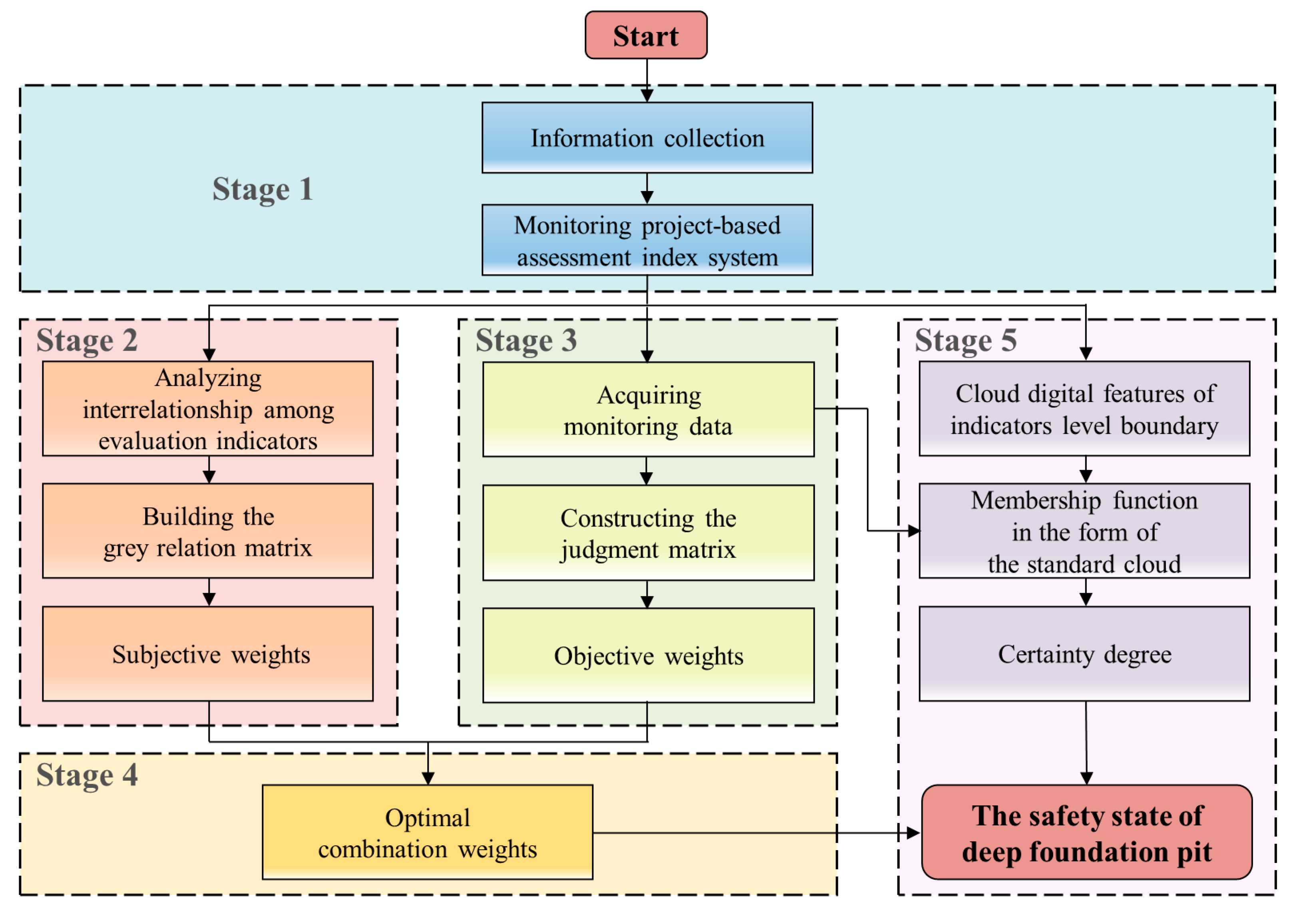
2.1. Assessment Index System
2.1.1. Assessment Index Content
2.1.2. Quantification of Indicator Safety Level
2.2. Subjective Weight Determination
- Define the grey linguistic scale:
- 2.
- Build the grey relation matrix:
- 3.
- Convert grey numbers into crisp scores:
- 4.
- Calculate the comprehensive relation matrix:
- 5.
- Determine the subjective weights:
2.3. Objective Weight Determination
- Construct the judgment matrix:
- 2.
- Normalize the judgment matrix:
- 3.
- Calculate the information entropy of the evaluation index:
- 4.
- Determine the objective weights of the evaluation index:
2.4. Combination Weight Determination
2.5. Comprehensive Evaluation
2.5.1. The Normal Cloud Model
2.5.2. Evaluation Based on the Game-CM
- Generate standard cloud:
- 2.
- Determine synthetic certainty degree:
- 3.
- Calculate the synthetic safety level:
3. Case Study
3.1. Project Overview
3.2. Assessment Area and Data Acquisition
3.3. Weight Determination
3.3.1. Subjective Weight
3.3.2. Objective Weight
3.3.3. Combination Weight
3.4. Comprehensive Evaluation
3.4.1. Cloud Model for the Deep Foundation Pit Safety Status
3.4.2. Synthetic Safety Level Calculation
3.5. Discussion
3.5.1. Index Weight Analysis
3.5.2. Comparison with Traditional Methods
4. Conclusions
- (1)
- Using national standards as a guide, monitoring items were determined by the design safety classification of the foundation pit. Then, the items exhibiting low sensitivity were excluded. The 11 monitoring indicators reflecting the stability of DFP were selected to build the evaluation index system.
- (2)
- A combination weights assignment method was established based on the game theory of integrating GDEMATEL with the entropy method. Through a case calculation, the results indicated that game theory effectively calibrated the disparity between subjective and objective weights. Additionally, the weights of the change rate indices were generally larger than those of the cumulative value indices for the same monitoring item.
- (3)
- In an engineering case, this method was applied by selecting a monitoring data alarm zone as the assessment object. Concurrently, the everyday most dangerous values of various monitoring items in this zone were collected. These data were then used to conduct a 19-day dynamic assessment for the DFP safety condition. The assessment results revealed that throughout this period, the DFP synthetic safety level consistently ranged between grades I and II, corresponding to negligible and acceptable in the acceptance criteria. The reliability of the results was also verified by on-site observation and subsequent follow-up monitoring. Nonetheless, specific evaluation results demonstrated ambiguous grade boundaries, and the method still needs further research for refinement.
- (4)
- The Game-CM, which integrates multi-source monitoring information, aligns more closely with on-site observations than single-indicator monitoring warnings. In the multi-indicator approach, this method is superior to the TFCE method, as it considers the randomness and uncertainty of the process in the conversion of qualitative concepts into quantitative expressions, as well as the weak contribution of the minimum and maximum values of the different safety level boundaries to that level when determining the membership function.
- (5)
- The calculation process of the Game-CM method can be realized through appropriate Excel processing and MATLAB programming. All that is required is to input the subjective scoring information and monitoring data; then, the evaluation results can be obtained within a minute. It enables security managers to promptly judge the stability of DFP from a multiple monitoring indicator perspective, circumventing the resource waste caused by focusing solely on recurrent alerts from a single index.
Author Contributions
Funding
Institutional Review Board Statement
Informed Consent Statement
Data Availability Statement
Conflicts of Interest
Appendix A
| Unit (Expert Number) | Title | Education Background |
|---|---|---|
| Construction (1) | Project manager | Master |
| Design (1) | Chief project engineer | Master |
| Supervision (1) | Safety director | Master |
| College (2) | Professor | Doctor |
References
- Chen, J.J.; Zhang, W.; Wang, J.H. Data Fusion Analysis Method for Assessment on Safety Monitoring Results of Deep Excavations. J. Aerosp. Eng. 2017, 30, B4015005. [Google Scholar] [CrossRef]
- Fu, L.P.; Wang, X.Q.; Zhao, H.; Li, M.N. Interactions among safety risks in metro deep foundation pit projects: An association rule mining-based modeling framework. Reliab. Eng. Syst. Saf. 2022, 221, 108381. [Google Scholar] [CrossRef]
- Sun, J.B.; Sun, K.; Gong, L.; Gu, S.; Hao, H. Health Assessment of Foundation Pit Based on the Fuzzy Analytical Hierarchy Process. Adv. Civ. Eng. 2022, 2022, 1–8. [Google Scholar] [CrossRef]
- Xia, Y.Y.; Chen, C.S.; Chen, J.P.; Zheng, X.Y.; Zhai, Y.X. Dynamic Risk Assessment of Deep Foundation Pit Construction Based on Field Monitoring. Chin. J. Undergr. Space Eng. 2016, 12, 1378–1384. [Google Scholar]
- Li, W.H.; Zhang, S.J.; Hong, X.; Luan, J.L.; Tan, Y. Risk assessment of diaphragm wall leakage during subway excavation based on field monitoring data. J. Hefei Univ. Technol. 2022, 45, 60–66. [Google Scholar]
- Lyu, H.M.; Sun, W.J.; Shen, S.L.; Zhou, A.N. Risk Assessment Using a New Consulting Process in Fuzzy AHP. J. Constr. Eng. Manage. 2020, 146, 4019112. [Google Scholar] [CrossRef]
- Zhang, W.; Huang, Z.; Zhang, J.; Zhang, R.; Ma, S. Multifactor Uncertainty Analysis of Construction Risk for Deep Foundation Pits. Appl. Sci. 2022, 12, 8122. [Google Scholar] [CrossRef]
- Soares, T.D.S.; Silva, M.M.; Santos, S.M. A hybrid Grey-DEMATEL approach to identify barriers to the implementation of an end-of-life vehicle management system in Brazil. J. Clean. Prod. 2023, 386, 135791. [Google Scholar] [CrossRef]
- Guo, Q.J.; Amin, S.; Hao, Q.W.; Haas, O. Resilience assessment of safety system at subway construction sites applying analytic network process and extension cloud models. Reliab. Eng. Syst. Saf. 2020, 201, 106956. [Google Scholar] [CrossRef]
- Ma, Z.L.; Liu, J.; Chien, S.I.; Hu, X.F.; Shao, Y.H. Identifying Critical Stations Affecting Vulnerability of a Metro Network Considering Passenger Flow and Cascading Failure: Case of Xi’an Metro in China. Asce-Asme J. Risk Uncertain. Eng. Syst. Part A Civ. Eng. 2023, 9, 4023014. [Google Scholar] [CrossRef]
- Zhou, Y.X.; Tao, W.L.; Song, M.L. Regional Water Resource Security in China Based on a New Fuzzy Method with Combination Weighting. Int. J. Fuzzy Syst. 2022, 24, 18. [Google Scholar] [CrossRef]
- Wang, X.T.; Li, S.C.; Xu, Z.H.; Hu, J.; Pan, D.D.; Xue, Y.G. Risk assessment of water inrush in karst tunnels excavation based on normal cloud model. Bull. Eng. Geol. Environ. 2019, 78, 3783–3798. [Google Scholar] [CrossRef]
- Li, X.H.; Han, Z.Y.; Zhang, R.R.; Zhang, Y.; Zhang, L.Y. Risk assessment of hydrogen generation unit considering dependencies using integrated DEMATEL and TOPSIS approach. Int. J. Hydrogen Energy 2020, 45, 29630–29642. [Google Scholar] [CrossRef]
- Kim, J.; Kim, C.; Kim, G.; Kim, I.; Abbas, Q.; Lee, J. Probabilistic tunnel collapse risk evaluation model using analytical hierarchy process (AHP) and Delphi survey technique. Tunn. Undergr. Space Technol. 2022, 120, 104262. [Google Scholar] [CrossRef]
- Chen, C.; Zhang, L.M.; Tiong, R.L.K. A novel learning cloud Bayesian network for risk measurement. Appl. Soft Comput. 2020, 87, 105947. [Google Scholar] [CrossRef]
- Zhou, Y.; Su, W.J.; Ding, L.Y.; Luo, H.B.; Love, P.E.D. Predicting Safety Risks in Deep Foundation Pits in Subway Infrastructure Projects: Support Vector Machine Approach. J. Comput. Civ. Eng. 2017, 31, 14. [Google Scholar] [CrossRef]
- Zhang, Y.C.; Ding, L.Y.; Love, P.E.D. Planning of Deep Foundation Construction Technical Specifications Using Improved Case-Based Reasoning with Weighted k-Nearest Neighbors. J. Comput. Civ. Eng. 2017, 31, 4017029. [Google Scholar] [CrossRef]
- Wei, D.J.; Xu, D.S.; Zhang, Y. A fuzzy evidential reasoning-based approach for risk assessment of deep foundation pit. Tunn. Undergr. Space Technol. 2020, 97, 103232. [Google Scholar] [CrossRef]
- Lin, S.S.; Shen, S.L.; Zhou, A.N.; Xu, Y.S. Novel model for risk identification during karst excavation. Reliab. Eng. Syst. Saf. 2021, 209, 107435. [Google Scholar] [CrossRef]
- Shen, S.L.; Lin, S.S.; Zhou, A.N. A cloud model-based approach for risk analysis of excavation system. Reliab. Eng. Syst. Saf. 2023, 231, 108984. [Google Scholar] [CrossRef]
- Wu, J.; Zhou, Z.F. Risk assessment of seepage failure in deep excavations based on fuzzy analytic hierarchy process and cloud model. Acta Geotech. 2023, 1–24. [Google Scholar] [CrossRef]
- Cao, C.; Xu, P.H.; Chen, J.P.; Zheng, L.J.; Niu, C.C. Hazard Assessment of Debris-Flow along the Baicha River in Heshigten Banner, Inner Mongolia, China. Int. J. Environ. Res. Public Health 2017, 14, 30. [Google Scholar] [CrossRef] [PubMed]
- Wei, C.J.; Meng, J.J.; Zhu, L.K.; Han, Z.Y. Assessing progress towards sustainable development goals for Chinese urban land use: A new cloud model approach. J. Environ. Manag. 2023, 326, 116826. [Google Scholar] [CrossRef] [PubMed]
- Deng, F.; Pu, J.; Huang, Y.; Han, Q.D. 3D geological suitability evaluation for underground space based on the AHP-cloud model. Undergr. Space 2023, 8, 109–122. [Google Scholar] [CrossRef]
- GB50497-2019; Technical Standard for Monitoring of Building Excavation Engineering. PRC Ministry of Housing and Urban-Rural Development: Beijing, China, 2019.
- Yazdi, M.; Khan, F.; Abbassi, R.; Rusli, R. Improved DEMATEL methodology for effective safety management decision-making. Saf. Sci. 2020, 127, 104705. [Google Scholar] [CrossRef]
- Bai, C.G.; Sarkis, J. A grey-based DEMATEL model for evaluating business process management critical success factors. Int. J. Prod. Econ. 2013, 146, 281–292. [Google Scholar] [CrossRef]
- Deng, J.L. Introduction to grey system theory. J. Grey Syst. 1989, 1, 1–24. [Google Scholar]
- Bouzon, M.; Govindan, K.; Rodriguez, C.M.T. Evaluating barriers for reverse logistics implementation under a multiple stakeholders’ perspective analysis using grey decision making approach. Resour. Conserv. Recycl. 2018, 128, 315–335. [Google Scholar] [CrossRef]
- Kiani Mavi, R.; Standing, C. Critical success factors of sustainable project management in construction: A fuzzy DEMATEL-ANP approach. J. Clean. Prod. 2018, 194, 751–765. [Google Scholar] [CrossRef]
- Shannon, C.E. A mathematical theory of communication. Bell. Syst. Tech. J. 1948, 27, 379–423. [Google Scholar] [CrossRef]
- Delgado, A.; Romero, I. Environmental conflict analysis using an integrated grey clustering and entropy-weight method: A case study of a mining project in Peru. Environ. Model. Softw. 2016, 77, 108–121. [Google Scholar] [CrossRef]
- Roger, B.M. Game Theory—Analysis of Conflict; Harvard University Press: Cambridge, UK; London, UK, 1991. [Google Scholar]
- Lai, C.G.; Chen, X.H.; Chen, X.Y.; Wang, Z.L.; Wu, X.S.; Zhao, S.W. A fuzzy comprehensive evaluation model for flood risk based on the combination weight of game theory. Nat. Hazards 2015, 77, 1243–1259. [Google Scholar] [CrossRef]
- Li, D.; Cheung, D.; Shi, X.M.; Ng, V. Uncertainty reasoning based on cloud models in controllers. Comput. Math. Appl. 1998, 35, 99–123. [Google Scholar] [CrossRef]
- Huang, Z.; Zhang, W.; Sun, H.Y.; Pan, Q.J.; Zhang, J.B.; Li, Y.F. Risk uncertainty analysis in shield tunnel projects. Tunn. Undergr. Space Technol. 2023, 132, 104899. [Google Scholar] [CrossRef]
- Zhang, W.; Sun, K.; Lei, C.Z.; Zhang, Y.C.; Li, H.X.; Spencer, B.F. Fuzzy Analytic Hierarchy Process Synthetic Evaluation Models for the Health Monitoring of Shield Tunnels. Comput.-Aided Civ. Infrastruct. Eng. 2014, 29, 676–688. [Google Scholar] [CrossRef]

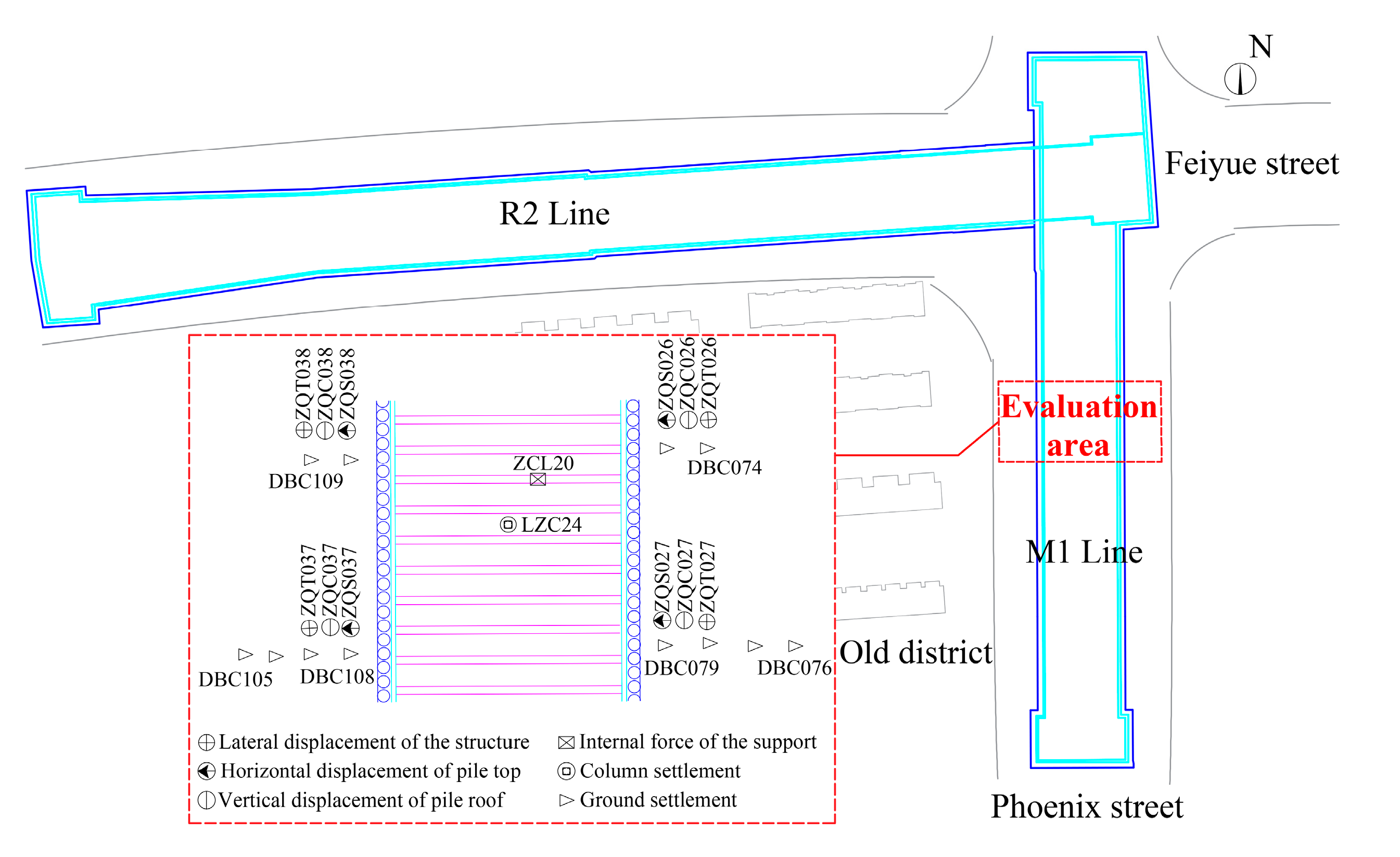
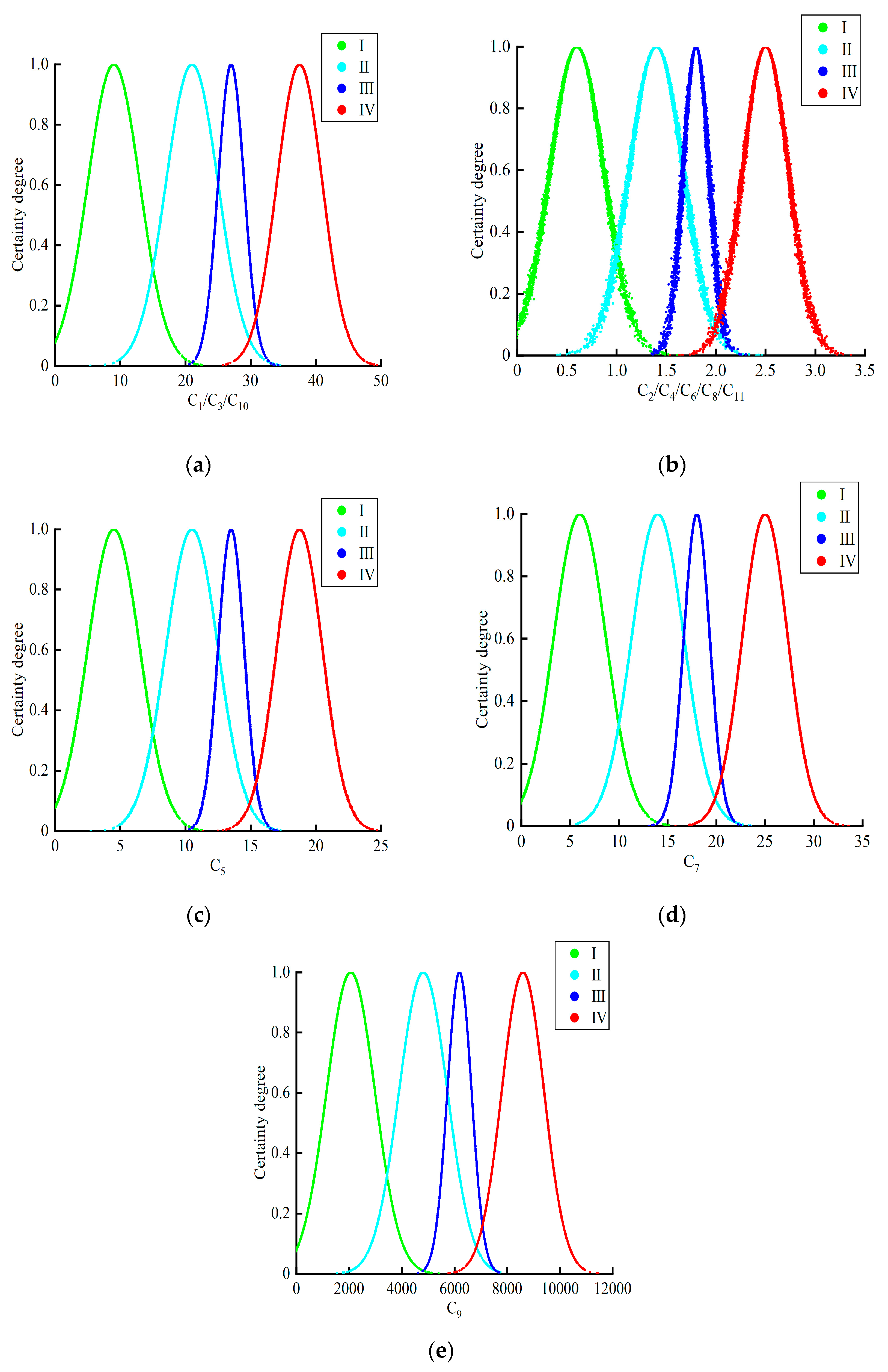
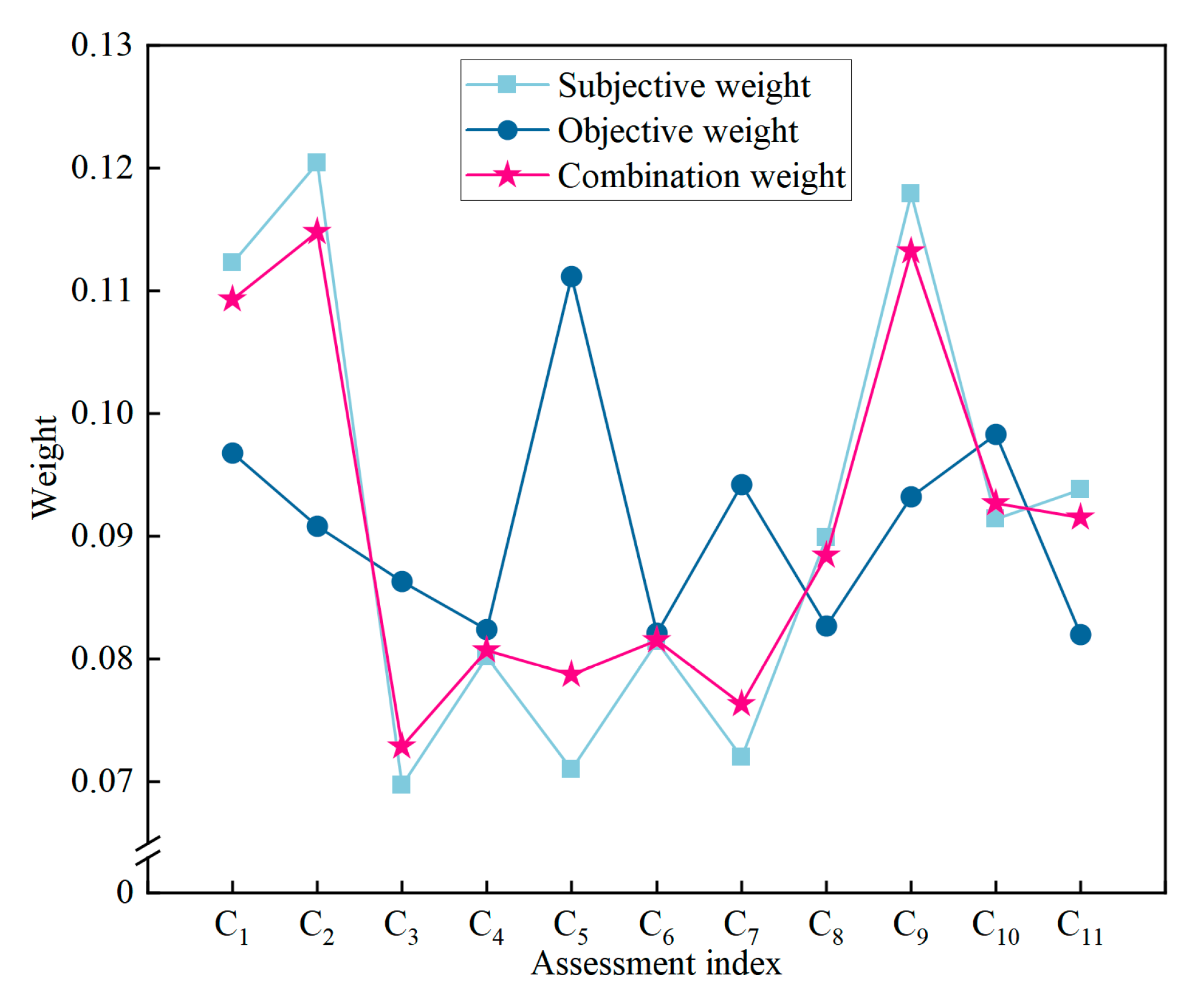
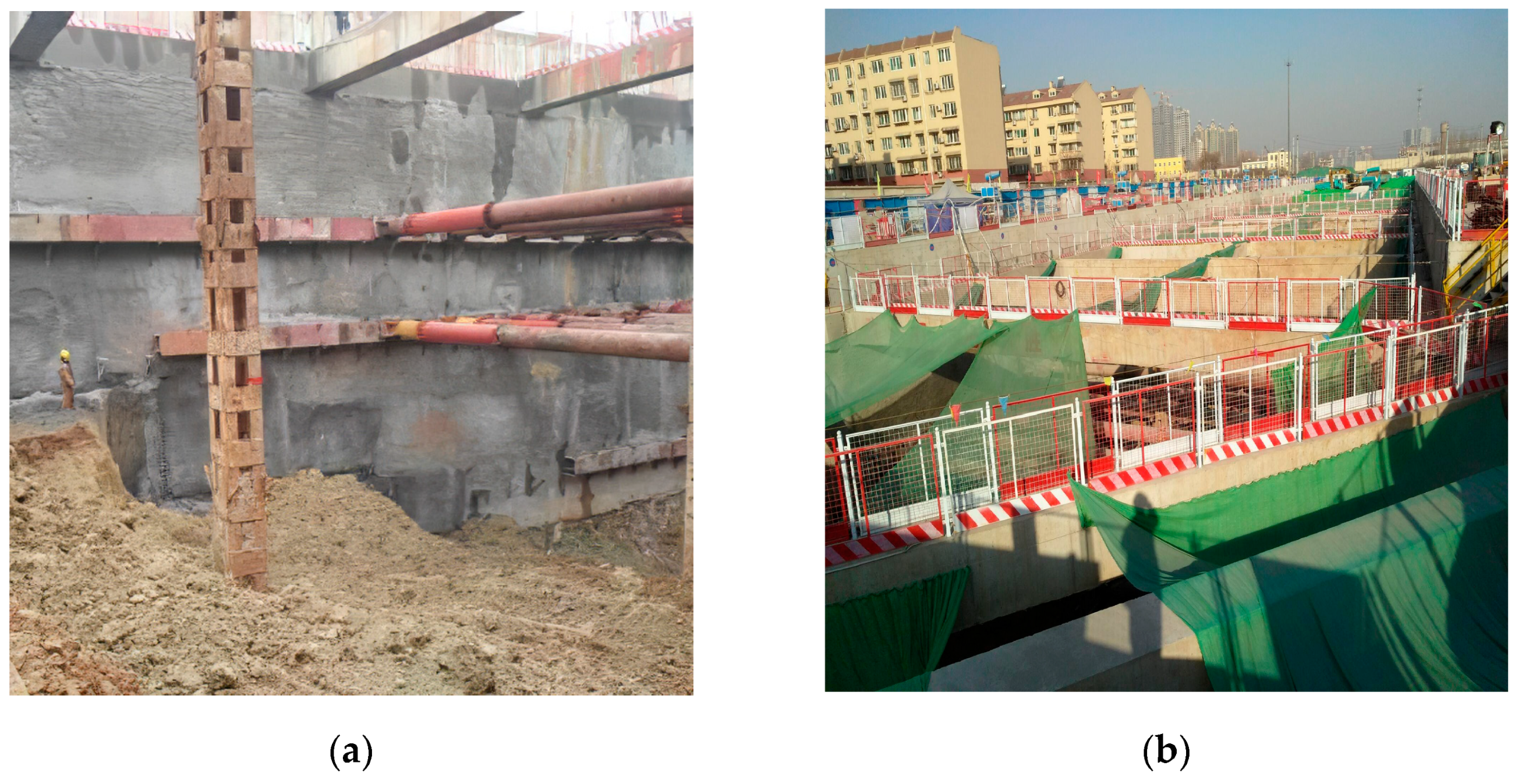
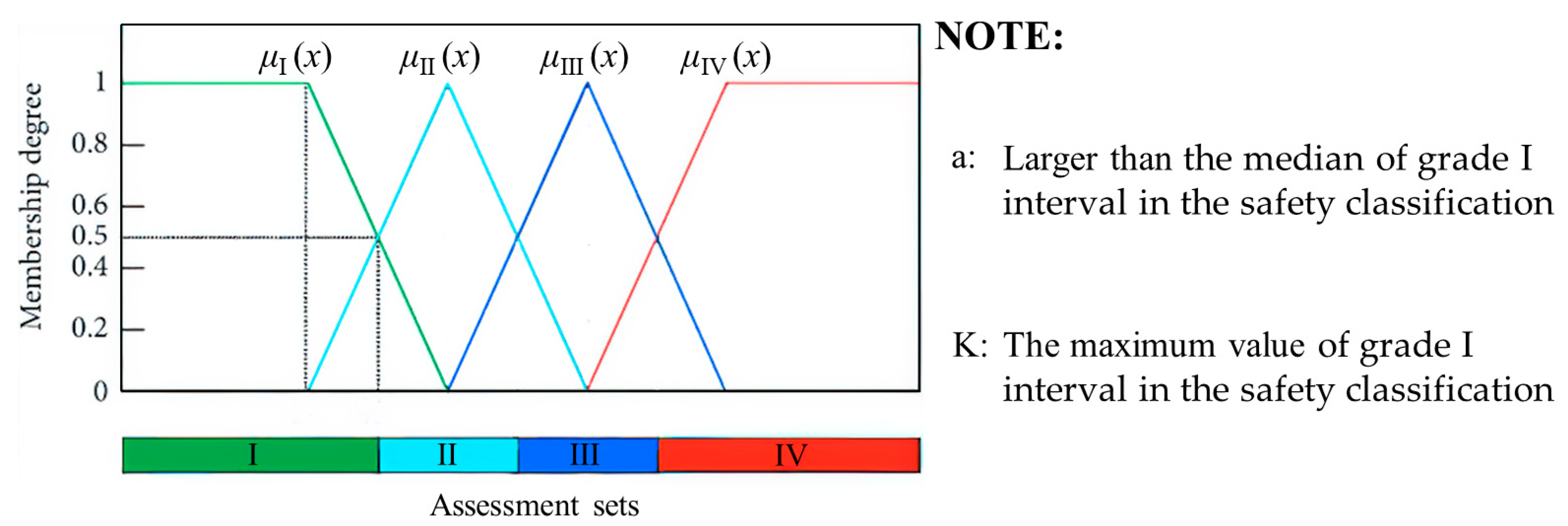
| Monitoring Project | Assessment Indices | Ⅰ | Ⅱ | Ⅲ | Ⅳ |
|---|---|---|---|---|---|
| Lateral displacement of the structure | Accumulative value (C1) | 0~18 | 18~24 | 24~30 | >30 |
| Change rate (C2) | 0~1.2 | 1.2~1.6 | 1.6~2 | >2 | |
| Horizontal displacement of pile top | Accumulative value (C3) | 0~18 | 18~24 | 24~30 | >30 |
| Change rate (C4) | 0~1.2 | 1.2~1.6 | 1.6~2 | >2 | |
| Vertical displacement of pile roof | Accumulative value (C5) | 0~9 | 9~12 | 12~15 | >15 |
| Change rate (C6) | 0~1.2 | 1.2~1.6 | 1.6~2 | >2 | |
| Column settlement | Accumulative value (C7) | 0~12 | 12~16 | 16~20 | >20 |
| Change rate (C8) | 0~1.2 | 1.2~1.6 | 1.6~2 | >2 | |
| Internal force of the support | Accumulative value (C9) | 0~4125 | 4125~5500 | 5500~6875 | >6875 |
| Ground settlement | Accumulative value (C10) | 0~18 | 18~24 | 24~30 | >30 |
| Change rate (C11) | 0~1.2 | 1.2~1.6 | 1.6~2 | >2 |
| Linguistic Terms | Scale | Grey Number |
|---|---|---|
| No influence (N) | 0 | [0, 0.25] |
| Very low influence (VL) | 1 | [0, 0.5] |
| Low influence (L) | 2 | [0.25, 0.75] |
| High influence (H) | 3 | [0.5, 1] |
| Very high influence (VH) | 4 | [0.75, 1] |
| Safety Level | Acceptance Criteria | Disposal Principle |
|---|---|---|
| Ⅰ | Negligible | Risk management can be implemented |
| Ⅱ | Acceptable | Formulating plans to curb the deformation |
| Ⅲ | Reluctant to accept | Developing warning response measures; Increasing the monitoring in the warning sites |
| Ⅳ | Unacceptable | Ceasing construction; Developing plans to eliminating hazards at once; Strengthening monitoring and inspection frequency |
| Assessment Indices | C1 | C2 | C3 | C4 | C5 | C6 |
| Monitoring point | ZQT026 | ZQS026 | ZQC027 | |||
| Value | 39.45 | 1.06 | 12.32 | 0.22 | 10.89 | 0.13 |
| Safety level | IV | I | I | I | II | I |
| Assessment Indices | C7 | C8 | C9 | C10 | C11 | |
| Monitoring point | LZC24 | ZCL20 | DBC076 | |||
| Value | 11.56 | 0.35 | 6854.81 | 18.52 | 0.08 | |
| Safety level | II | I | III | II | I | |
| Indices | C1 | C2 | C3 | C4 | C5 | C6 | C7 | C8 | C9 | C10 | C11 |
|---|---|---|---|---|---|---|---|---|---|---|---|
| C1 | 0 | 2 | 1 | 2 | 1 | 2 | 1 | 2 | 3 | 2 | 2 |
| C2 | 3 | 0 | 2 | 2 | 1 | 2 | 1 | 2 | 3 | 2 | 2 |
| C3 | 2 | 2 | 0 | 2 | 1 | 1 | 1 | 1 | 2 | 1 | 1 |
| C4 | 2 | 2 | 2 | 0 | 1 | 1 | 1 | 1 | 2 | 1 | 2 |
| C5 | 2 | 2 | 1 | 1 | 0 | 2 | 2 | 2 | 1 | 2 | 2 |
| C6 | 1 | 1 | 1 | 1 | 2 | 0 | 3 | 3 | 1 | 1 | 2 |
| C7 | 2 | 2 | 1 | 1 | 2 | 2 | 0 | 2 | 2 | 1 | 1 |
| C8 | 1 | 2 | 2 | 2 | 2 | 3 | 2 | 0 | 2 | 1 | 1 |
| C9 | 2 | 3 | 2 | 2 | 1 | 2 | 2 | 2 | 0 | 2 | 2 |
| C10 | 3 | 3 | 2 | 2 | 1 | 1 | 1 | 1 | 3 | 0 | 2 |
| C11 | 3 | 3 | 2 | 2 | 2 | 1 | 1 | 1 | 1 | 2 | 0 |
| Indices | C1 | C2 | C3 | C4 | C5 | C6 |
| Subjectivity | 0.1123 | 0.1204 | 0.0697 | 0.0802 | 0.0710 | 0.0814 |
| Objectivity | 0.0968 | 0.0908 | 0.0863 | 0.0824 | 0.1112 | 0.0821 |
| Combination | 0.1093 | 0.1148 | 0.0729 | 0.0807 | 0.0787 | 0.0815 |
| Indices | C7 | C8 | C9 | C10 | C11 | - |
| Subjectivity | 0.0720 | 0.0899 | 0.1179 | 0.0914 | 0.0938 | - |
| Objectivity | 0.0942 | 0.0827 | 0.0932 | 0.0983 | 0.0820 | - |
| Combination | 0.0763 | 0.0884 | 0.1132 | 0.0927 | 0.0915 | - |
| Assessment Indices | Ⅰ | Ⅱ | Ⅲ | Ⅳ |
|---|---|---|---|---|
| C1 | (9, 4, 0.01) | (21, 4, 0.01) | (27, 2, 0.01) | (37.5, 3.5, 0.01) |
| C2 | (0.6, 0.27, 0.01) | (1.4, 0.27, 0.01) | (1.8, 0.13, 0.01) | (2.5, 0.23, 0.01) |
| C3 | (9, 4, 0.01) | (21, 4, 0.01) | (27, 2, 0.01) | (37.5, 3.5, 0.01) |
| C4 | (0.6, 0.27, 0.01) | (1.4, 0.27, 0.01) | (1.8, 0.13, 0.01) | (2.5, 0.23, 0.01) |
| C5 | (4.5, 2, 0.01) | (10.5, 2, 0.01) | (13.5, 1, 0.01) | (18.75, 1.75, 0.01) |
| C6 | (0.6, 0.27, 0.01) | (1.4, 0.27, 0.01) | (1.8, 0.13, 0.01) | (2.5, 0.23, 0.01) |
| C7 | (6, 2.67, 0.01) | (14, 2.67, 0.01) | (18, 1.33, 0.01) | (25, 2.33, 0.01) |
| C8 | (0.6, 0.27, 0.01) | (1.4, 0.27, 0.01) | (1.8, 0.13, 0.01) | (2.5, 0.23, 0.01) |
| C9 | (2062.5, 916.67, 0.01) | (4812.5, 916.67, 0.01) | (6187.5, 458.33, 0.01) | (8594, 802.17, 0.01) |
| C10 | (9, 4, 0.01) | (21, 4, 0.01) | (27, 2, 0.01) | (37.5, 3.5, 0.01) |
| C11 | (0.6, 0.27, 0.01) | (1.4, 0.27, 0.01) | (1.8, 0.13, 0.01) | (2.5, 0.23, 0.01) |
| Sample | Synthetic Certainty Degree | Game-CM Method | |||
|---|---|---|---|---|---|
| MⅠ | MⅡ | MⅢ | MⅣ | ||
| 21 June | 0.3127 | 0.3034 | 0.1420 | 0.0013 | Ⅰ |
| 22 June | 0.3745 | 0.2736 | 0.1359 | 0.0036 | Ⅰ |
| 23 June | 0.3814 | 0.2796 | 0.1260 | 0.0036 | Ⅰ |
| 24 June | 0.3325 | 0.2771 | 0.1040 | 0.0053 | Ⅰ |
| 25 June | 0.3448 | 0.2714 | 0.0871 | 0.0073 | Ⅰ |
| 26 June | 0.3947 | 0.2834 | 0.0690 | 0.0100 | Ⅰ |
| 27 June | 0.2988 | 0.3158 | 0.0694 | 0.0190 | Ⅱ |
| 28 June | 0.2207 | 0.3054 | 0.1035 | 0.0321 | Ⅱ |
| 29 June | 0.2595 | 0.3212 | 0.1137 | 0.0504 | Ⅱ |
| 30 June | 0.1601 | 0.3445 | 0.1035 | 0.0797 | Ⅱ |
| 1 July | 0.2124 | 0.3361 | 0.0796 | 0.1025 | Ⅱ |
| 2 July | 0.1880 | 0.3118 | 0.0648 | 0.1142 | Ⅱ |
| 3 July | 0.2055 | 0.3169 | 0.0548 | 0.1139 | Ⅱ |
| 4 July | 0.1902 | 0.2735 | 0.0471 | 0.1043 | Ⅱ |
| 5 July | 0.2622 | 0.2243 | 0.0783 | 0.1019 | Ⅰ |
| 6 July | 0.1786 | 0.2291 | 0.1064 | 0.1025 | Ⅱ |
| 7 July | 0.2131 | 0.2381 | 0.1191 | 0.1048 | Ⅱ |
| 8 July | 0.3114 | 0.2448 | 0.1119 | 0.1078 | Ⅰ |
| 9 July | 0.2555 | 0.2532 | 0.0955 | 0.1091 | Ⅰ |
| Sample | Synthetic Safety Level | Sample | Synthetic Safety Level | ||||
|---|---|---|---|---|---|---|---|
| Game-CM Method | TFCE Method | Field Monitoring | Game-CM Method | TFCE Method | Field Monitoring | ||
| 21 June | Ⅰ | Ⅰ | Ⅲ | 1 July | Ⅱ | Ⅰ | Ⅳ |
| 22 June | Ⅰ | Ⅰ | Ⅲ | 2 July | Ⅱ | Ⅰ | Ⅳ |
| 23 June | Ⅰ | Ⅰ | Ⅲ | 3 July | Ⅱ | Ⅰ | Ⅳ |
| 24 June | Ⅰ | Ⅰ | Ⅲ | 4 July | Ⅱ | Ⅰ | Ⅳ |
| 25 June | Ⅰ | Ⅰ | Ⅲ | 5 July | Ⅰ | Ⅰ | Ⅳ |
| 26 June | Ⅰ | Ⅰ | Ⅲ | 6 July | Ⅱ | Ⅰ | Ⅳ |
| 27 June | Ⅱ | Ⅰ | Ⅳ | 7 July | Ⅱ | Ⅰ | Ⅳ |
| 28 June | Ⅱ | Ⅰ | Ⅳ | 8 July | Ⅰ | Ⅰ | Ⅳ |
| 29 June | Ⅱ | Ⅰ | Ⅳ | 9 July | Ⅰ | Ⅰ | Ⅳ |
| 30 June | Ⅱ | Ⅰ | Ⅳ | - | - | - | - |
Disclaimer/Publisher’s Note: The statements, opinions and data contained in all publications are solely those of the individual author(s) and contributor(s) and not of MDPI and/or the editor(s). MDPI and/or the editor(s) disclaim responsibility for any injury to people or property resulting from any ideas, methods, instructions or products referred to in the content. |
© 2023 by the authors. Licensee MDPI, Basel, Switzerland. This article is an open access article distributed under the terms and conditions of the Creative Commons Attribution (CC BY) license (https://creativecommons.org/licenses/by/4.0/).
Share and Cite
Wu, B.; Wei, Y.; Meng, G.; Xu, S.; Wang, Q.; Cao, D.; Zhao, C. Multi-Source Monitoring Data Fusion Comprehensive Evaluation Method for the Safety Status of Deep Foundation Pit. Sustainability 2023, 15, 11809. https://doi.org/10.3390/su151511809
Wu B, Wei Y, Meng G, Xu S, Wang Q, Cao D, Zhao C. Multi-Source Monitoring Data Fusion Comprehensive Evaluation Method for the Safety Status of Deep Foundation Pit. Sustainability. 2023; 15(15):11809. https://doi.org/10.3390/su151511809
Chicago/Turabian StyleWu, Bo, Yu Wei, Guowang Meng, Shixiang Xu, Qinshan Wang, Dianbin Cao, and Chenxu Zhao. 2023. "Multi-Source Monitoring Data Fusion Comprehensive Evaluation Method for the Safety Status of Deep Foundation Pit" Sustainability 15, no. 15: 11809. https://doi.org/10.3390/su151511809
APA StyleWu, B., Wei, Y., Meng, G., Xu, S., Wang, Q., Cao, D., & Zhao, C. (2023). Multi-Source Monitoring Data Fusion Comprehensive Evaluation Method for the Safety Status of Deep Foundation Pit. Sustainability, 15(15), 11809. https://doi.org/10.3390/su151511809








